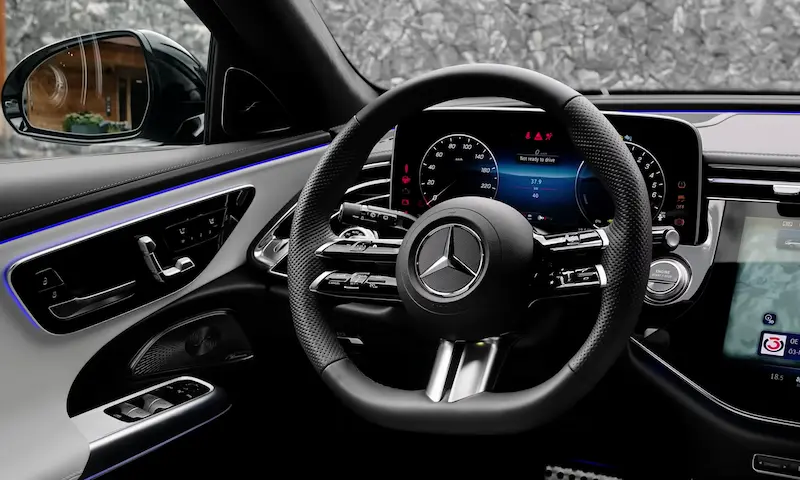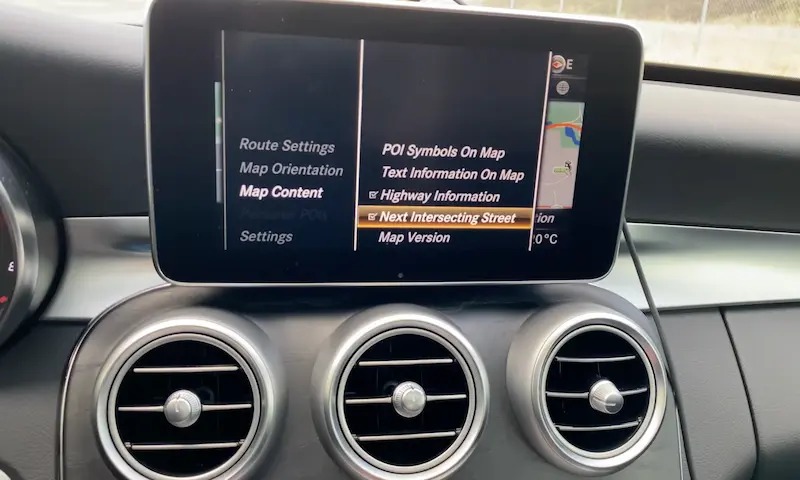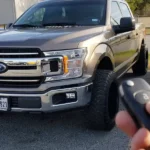Facing issues when you turn the key in a Mercedes and nothing happens can be frustrating. The main culprits could be a dead battery or a faulty ignition switch. These common problems can leave you stranded, but don’t worry. This article will guide you through possible fixes and help you get back on the road quickly. Keep reading to learn how you can solve this issue and drive worry-free.
Understanding Your Mercedes-Benz Ignition System
When you turn the key or press the button on a Mercedes-Benz, you rely on a sophisticated ignition system to start the engine. This system includes several key components like the electronic ignition switch and the drive authorization system to ensure your car starts correctly and securely.
Components of the Electronic Ignition/Switch System
The heart of your Mercedes-Benz starting process is the electronic ignition switch (EIS). This component communicates with the smart key remote when you press the button or turn the key. The EIS verifies the key’s code to allow the engine to start. If there is a defect in the EIS module, it might fail to recognize the key, causing the car not to start.
Another key component is the smart key remote. It uses radio frequencies to send a unique signal to the ignition switch. If the smart key’s battery is low or the key is damaged, this might prevent the car from starting. Keeping the key fob in good condition is crucial for the consistent operation of your vehicle.
Role of the Drive Authorization System
The drive authorization system is another vital part of your car’s ignition. It works in conjunction with the electronic ignition switch to provide an extra layer of security. It ensures that the electronic control unit (ECU) receives the correct signal from your smart key and the ignition switch before enabling the engine to start.
This system prevents the car from starting if there is any discrepancy or if an unauthorized key attempts to access the vehicle. Issues with this system, such as defects or synchronization problems, can lead to situations where you turn the key, and nothing happens. Regular maintenance and ensuring your key fob functions properly can help avoid these issues.
Common Reasons for Ignition Failure
When your Mercedes key turns and nothing happens, it can be frustrating. Several common issues might be causing your car not to start, from battery problems to key-related complications. Understanding these can help you diagnose and fix the problem efficiently.
Dead or Discharged Battery Issues
One of the primary reasons for ignition failure is a dead battery. If your car’s battery is discharged, it won’t provide enough power to start the engine. Signs of a dead battery include dim lights and no engine sound when you turn the key.
To check, you can test the battery voltage using a multimeter. A healthy battery should read around 12.6 volts. If it’s lower, charging or replacing the battery might solve the issue. Regular maintenance can prevent unexpected failures.
Faults in the Electronic Ignition Switch (EIS) Module
The electronic ignition switch (EIS) module can also cause problems if it’s faulty. This module communicates with your car’s computer system and the key. If there’s a fault here, your car may not start even if other parts are working.
Common signs include intermittent starting issues or the key not being recognized. A diagnostic scan tool can help identify EIS-related problems. Repairing or replacing the module might be necessary if it’s defective.
Problems with the Key Tumbler and Steering Lock
The key tumbler and steering lock system can sometimes get jammed, preventing the key from turning. If your steering wheel is locked, gently move it from side to side while turning the key. A locked steering wheel might feel completely solid in one direction.
A worn tumbler can also make it difficult to turn the key. Inspecting both the tumbler and steering lock for signs of damage can help identify any mechanical issues that require attention.
Transponder Coil and Key-Related Complications
A transponder coil in your vehicle communicates with the key’s chip to allow starting. If there’s an issue, your car may fail to start. A bad key fob or an improperly programmed key can also interfere with the starting process.
If you suspect a key issue, reprogramming or replacing the key fob might help. Additionally, checking the transponder coil for damage and ensuring proper communication between the coil and key is essential for resolving these problems. Regular checks can aid in avoiding key-related failures.
Diagnostic and Troubleshooting Techniques
When your Mercedes key turns but nothing happens, there are several steps you can take to diagnose and fix the issue. This can include using tools like a multimeter or software such as Mercedes-Benz Star Diagnostic.
How to Use a Multimeter to Check for Power Issues
To begin, you’ll want to use a multimeter to see if there are any power issues. Set your multimeter to measure voltage. Open the hood and locate the battery terminals. Connect the multimeter probes to the positive and negative terminals. Check if the battery voltage is around 12.6 volts; anything less might mean your battery needs charging or replacement.
Next, inspect the fuse box. Use the multimeter to test each fuse by placing the probes on the terminals of each fuse. A good fuse will show full continuity, while a bad one won’t.
It’s also important to examine the starter motor and alternator. Verify their connections and use the multimeter to check if they supply power when the key is turned.
Identifying Electronic Control Module (ECM) Malfunctions
The Electronic Control Module (ECM) can sometimes be the culprit. An ECM issue can cause your car not to start as it controls many electronic functions.
Check for rapidly flashing lights or error messages that might indicate ECM problems. You might need to reset the module to see if that solves the problem.
Inspect the wiring and connections leading to the ECM. Loose connections can create issues. If necessary, consult with a professional to test the ECM using specialized equipment.
Interpreting Mercedes-Benz Star Diagnostic Software Readouts
Using the Mercedes-Benz Star Diagnostic Software offers a deeper understanding of your car’s issues. Connect the diagnostic tool to the car’s OBD-II port, usually under the dashboard on the driver’s side.
Launch the software and run a full scan of the vehicle. Look for any error codes that might point to the ignition, ECM, or other problems. Pay attention to codes related to the EIS (Electronic Ignition System) or the ECU.
The software provides detailed readouts and suggested fixes, making it a powerful tool for diagnosis. Fixing these issues often requires some technical know-how or guidance from a Mercedes-Benz technician.
Resolving the Issue
If your Mercedes isn’t starting when you turn the key, it could be due to a few common problems. These issues might include a dead battery, problems with the steering wheel lock, an EIS module that needs replacement, or a need to reprogram your key and smart key remote. Each of these has specific steps you can follow to try to resolve the problem.
Jumpstarting a Dead Battery
A dead battery is often the culprit when your car won’t start. The simplest way to check this is by trying to jumpstart your battery. First, find a set of jumper cables and a friend’s running vehicle with a working battery. Connect the red cable to the positive terminals on both batteries.
Next, connect the black cable to the negative terminal on the working battery and to an unpainted metal surface on your car. Start the other vehicle and let it run for a few minutes. Then, try starting your Mercedes. If it starts, leave it running a while to recharge the battery. If not, your battery might need replacing.
Resetting the Steering Wheel Lock
Sometimes, the steering wheel lock can prevent your Mercedes from starting. Start by trying to turn the wheel while simultaneously turning the ignition key. This action could release the lock. If the wheel feels stuck, it might be the lock causing the issue.
To reset the lock, take the key out and reinsert it, then try to turn the wheel and key again. If this doesn’t work, the issue might be more complex, requiring professional intervention.
EIS Module Replacement Steps
The Electronic Ignition Switch (EIS) module is a key component of the drive authorization system (DAS). If it’s faulty, you may experience starting issues. Begin by contacting a qualified technician to run diagnostics on your Mercedes.
If replacement is needed, it involves programming the new module to match your car’s system. This isn’t a DIY task and should be handled by a professional to ensure proper functioning and security.
Key and Remote Smart Key Reprogramming
Issues with the smart key remote can also result in starting problems. To reprogram the smart key, you typically need to have access to a dealer or a specialist equipped with the necessary tools.
Reprogramming might involve inserting the key into the ignition and following specific button-pressing sequences. Often, this resets the communication between the key and the car’s systems, restoring functionality. Always refer to your car manual or consult an expert for the exact procedure.
Preventative Measures and Best Practices
To ensure your Mercedes-Benz starts smoothly, focus on keeping the battery in good shape and using diagnostic tools for regular checkups. By taking these steps, you can avoid issues like a faulty electronic ignition system or a smart key remote that doesn’t work.
Maintaining Your Mercedes-Benz Battery
Keeping your battery in top condition is crucial. Check the battery terminals for corrosion every few months. Corrosion can prevent the car from starting when you turn the key. Clean off any rust or buildup with a mixture of baking soda and water using a soft brush.
Regular inspections will help you identify potential problems before they become serious. Ensure your battery has the right charge. A drop in voltage might mean it’s time for a replacement. Consider using a trickle charger if you park your car for long periods. This keeps the battery well-maintained without overcharging.
Monitor battery age. Most car batteries last about 3-5 years, so watch for signs of aging like slow starts. Replace the battery promptly to avoid getting stranded with a car that won’t start.
Scheduled Checkups Using Diagnostic Equipment
Routine checkups are essential, especially for modern cars that use electronic systems. Make it a habit to visit a certified Mercedes-Benz service center where technicians can use diagnostic equipment on your vehicle. This equipment can detect issues affecting the electronic ignition system, smart key remote, or other key components.
Having a professional checkup means potential problems are identified early. Technicians can pinpoint whether failing parts need fixing or replacing. They’ll also update software in your vehicle’s computer systems if needed, which helps keep everything running smoothly.
Benefits of these checkups include increased safety, better fuel efficiency, and a reduced risk of unexpected breakdowns. By scheduling regular diagnostics, you ensure your Mercedes continues to deliver the luxury performance you expect.











